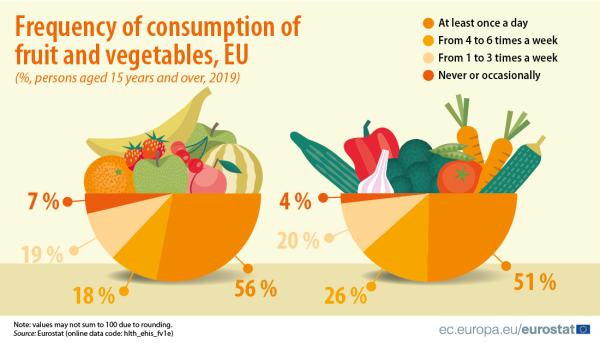Nutritional habits statistics
Data extracted June 2022. The data presented in this article refer to 2019.
Planned article update: July 2027.
Highlights
In 2019, two thirds of the EU population ate at least one portion of fruit and vegetables on a daily basis.
In 2019, people in the EU with a tertiary education were more likely to eat at least five portions of fruit and vegetables daily than those with a lower educational level.
In 2019, the share of the EU population eating at least five portions of fruit and vegetables daily rose with increasing income.
This article presents statistics on the consumption of fruit and vegetables across the European Union (EU). The indicators presented in the article reflect selected aspects of food habits and are used to monitor progress towards a healthy diet. They refer to the frequency of eating fruit, vegetables, fruit/vegetable juice and sugar-sweetened soft drinks, as well as the number of portions of fruit and vegetables consumed on a daily basis. More information on the coverage of each of these products is provided in the section on Data sources.
The statistics reported in this article come from the third wave of the European health interview survey (EHIS) which was conducted in 2019 and which covered persons aged 15 years and over. These data indicate differences across the EU concerning the amount and frequency of fruit and vegetables consumed, especially across sexes and different educational and income levels.
This article is one of a set of statistical articles concerning health determinants in the EU which forms part of an online publication on health statistics.
Full article
Consumption of fruit and vegetables
Around two thirds of the EU population ate at least one portion of fruit and vegetables on a daily basis
Figure 1 focuses on the proportion of the population according to the number of portions of fruit and vegetables consumed per day. A portion is more or less a handful (for instance, one apple or banana, two plums, a good slice of pineapple, two broccoli spears, three heaped tablespoons of cooked carrots, two-inch piece of cucumber, one medium tomato). In 2019, 67.1 % of the EU population aged 15 years and over reported eating at least one portion of fruit and vegetables on a daily basis. This percentage varied from less than 50 % in Latvia and Romania to more than 75.0 % in Italy, Spain, Ireland and Belgium.
On average, more than half of the population in the EU reported in 2019 that they consumed from one to four portions of fruit and vegetables per day, while about one in eight reported a daily consumption of at least five portions. Among the EU Member States, the daily consumption of at least five portions of fruit and vegetables differed widely. Around 3 in 10 people in Ireland (32.9 %) and the Netherlands (29.5 %) consumed at least five portions of fruit and vegetables per day, compared with less than 6.0 % in Austria, Slovenia, Bulgaria and Romania.

(%)
Source: Eurostat (hlth_ehis_fv3e)
Persons with tertiary educational attainment were most likely to eat at least five portions of fruit and vegetables daily
Around one in six (16.4 %) of the EU population with a high level of educational attainment (tertiary education) reported in 2019 eating at least five portions of fruit and vegetables per day, followed by those with a low level (at most, lower secondary education; 11.5 %) and then those with a medium level (upper secondary and post-secondary non-tertiary education; 10.6 %) – see Figure 2.
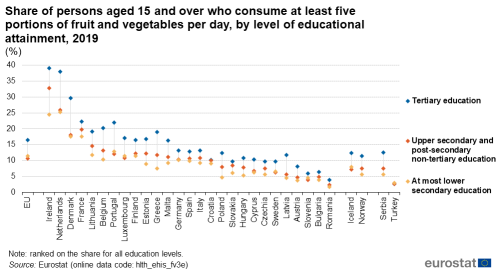
(%)
Source: Eurostat (hlth_ehis_fv3e)
This general situation of a higher share of people consuming at least five portions of fruit and vegetables per day among people with a high educational attainment was observed in 2019 across all EU Member States, as well as Iceland, Norway and Serbia. In Turkey, the shares were relatively low for all levels of education but were highest among people with a low level of educational attainment.
In most EU Member States, the lowest share of people consuming at least five portions of fruit and vegetables per day was among people with a low educational attainment. The only exceptions in 2019 were Portugal, Luxembourg, Slovenia and Sweden, where the lowest share was observed for people with a medium level of educational attainment.
The largest gap between those with a high and low educational level in the share of the population reporting a daily fruit and vegetable consumption of at least five portions was recorded in Ireland (a difference of 14.7 percentage points), followed by the Netherlands (12.7 percentage points difference), Denmark (12.1 percentage points difference) and Greece (11.3 percentage points difference).
The share of people eating at least five portions of fruit and vegetables per day was greater among people with higher income
The frequency in 2019 of a daily consumption of at least five portions of fruit and vegetables in the EU was higher among people with higher income (see Figure 3). In 2019, 10.8 % of the EU population in the first income quintile (the 20 % of the population with the lowest income) reported a consumption of at least five portions of fruit and vegetables as part of their daily diet. This compares with 11.3 % for the second income quintile, 12.0 % for the third income quintile, 12.9 % for the fourth income quintile and 14.8 % for the fifth income quintile (the 20 % of the population with the highest income).
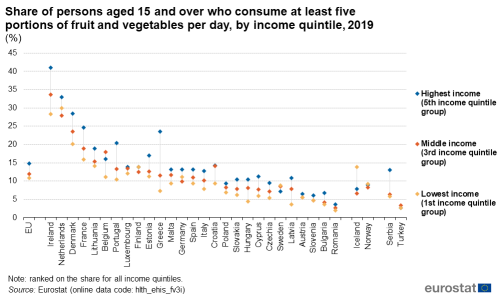
(%)
Source: Eurostat (hlth_ehis_fv3i)
In all but seven EU Member States (Belgium, Germany, the Netherlands, Austria, Slovenia, Finland and Sweden) the highest shares were recorded in the fifth income quintile, the lowest shares for the first income quintile, and shares for the third income quintile lying between these two. An opposite pattern was observed in Sweden, where the highest shares were recorded for persons in the lowest income quintile and the lowest shares in the highest income quintile. In Belgium, the share was higher for persons in the third income quintile than in either the first or fifth income quintiles. By contrast, in Germany, the Netherlands and Finland the share was lower in the third income quintile than in the first and fifth income quintiles. In Austria and Slovenia, although the highest share was observed for the fifth income quintile, identical shares were recorded for the first and third income quintiles.
Fruit consumption
In a small majority of EU Member States, more than half of the population ate fruit at least once a day
In the EU in 2019, 92.6 % of the population aged 15 years and over reported consuming fruit at least once a week; by contrast, 7.4 % ate fruit occasionally (less than once a week) or never.
- More than half (56.1 %) of the reference population ate fruit at least once a day.
- Close to one fifth (17.9 %) of the population ate fruit 4 to 6 times a week, in other words somewhat less than once a day, but more than every second day.
- Again, close to one fifth (18.5 %) of the population ate fruit 1 to 3 times a week, in other words at least once a week but less than every second day.
In 14 of the EU Member States, the share of the population aged 15 years and over who ate fruit at least once a day exceeded 50 % – see Figure 4. Across all Member States, this share varied from more than two thirds in Italy (69.3 %), Spain (67.8 %) and Portugal (66.8 %) to just over a third in Latvia (35.3 %) and just under a quarter in Romania (23.7 %). Note that this share is analysed by sex and educational attainment in Figures 5 and 6.
There were six EU Member States where at least 10.0 % of the reference population reported eating fruit occasionally or never in 2019: Belgium, Malta, Sweden, Romania, Denmark and Luxembourg. Shares of people occasionally or never eating fruit were below 5.0 % in Cyprus, Spain and Lithuania.
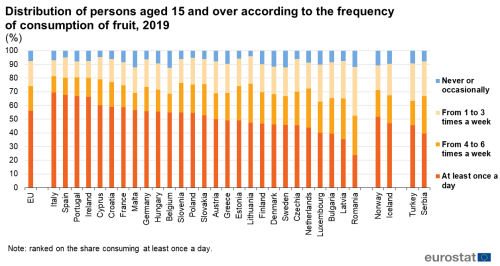
(%)
Source: Eurostat (hlth_ehis_fv1e)
More women than men consume fruit on a daily basis
The share of women aged 15 years and over in the EU reporting daily fruit consumption was more than three fifths (62.3 %) in 2019, while the equivalent share for men was just under half (49.4 %) – see Figure 5.
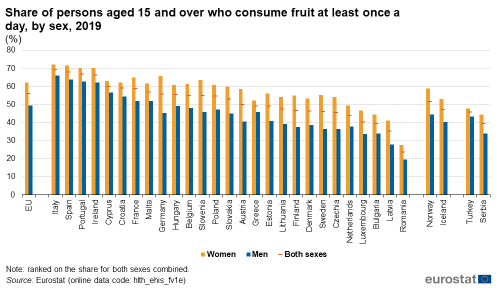
(%)
Source: Eurostat (hlth_ehis_fv1e)
Across the EU Member States, higher shares of daily fruit consumption in 2019 were consistently recorded for women than for men. The gender difference in daily fruit consumption was largest in Germany (20.4 percentage points), while differences of 15.0 to 20.0 percentage points were observed in seven other Member States. Gender differences concerning the daily consumption of fruit were below 10.0 percentage points in nine Member States, with the narrowest differences in several southern Member States – Spain, Portugal, Cyprus, Greece and Italy.
People with a high educational attainment were most likely to eat fruit daily
The share of the EU population aged 15 years and over who, in 2019, reported eating fruit at least once a day was 60.9 % among those with a high level of education (see Figure 6). The share of daily fruit consumption was lower among the population with medium or low levels of educational attainment.

(%)
Source: Eurostat (hlth_ehis_fv1e)
The same pattern was observed in 2019 among nearly all of the EU Member States. Slovenia was the only exception: people with a high level of educational attainment were the least likely to consume fruit daily while people with a low level of educational attainment were the most likely.
In 2019, the largest educational gaps concerning the daily consumption of fruit were observed in Greece, Bulgaria, Romania, Lithuania, Latvia and Denmark: the shares were at least 10.0 percentage points higher among people with a high level of educational attainment than among people in either of the other two levels of educational attainment.
Vegetable consumption
More than three quarters of the population in Belgium consumed vegetables at least once a day
In the EU in 2019, 96.4 % of the population aged 15 years and over reported consuming vegetables at least once a week; in other words, 3.6 % ate vegetables occasionally (less than once a week) or never. As such, vegetables were consumed at least once a week by a larger share of people in the EU than was observed for fruit.
- Just over half (50.6 %) of the reference population ate vegetables at least once a day.
- More than one quarter (26.3 %) of the population ate vegetables 4 to 6 times a week, in other words somewhat less than once a day, but more than every second day.
- Just under one fifth (19.5 %) of the population ate vegetables 1 to 3 times a week, in other words at least once a week but less than every second day.
In 11 of the EU Member States, the share of the population aged 15 years and over who ate vegetables at least once a day exceeded 50 % – see Figure 7. Across all Member States, this share varied from more than three quarters (76.4 %) in Belgium and 72.2 % in Ireland to 29.6 % in Malta and 17.4 % in Romania. Note that this share is analysed by sex and educational attainment in Figures 8 and 9.
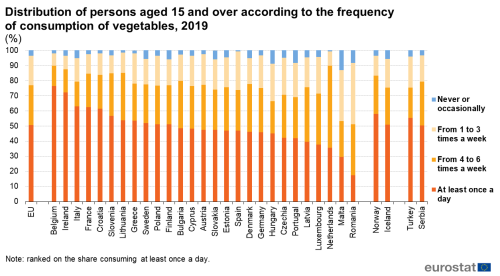
(%)
Source: Eurostat (hlth_ehis_fv1e)
A higher share of women than men consumed vegetables at least once a day in each of the EU Member States
Figure 8 presents an analysis of daily vegetable consumption by sex; there is a clear difference between the two sexes. The share of women aged 15 years and over in the EU eating vegetables at least once a day was 56.7 % in 2019. For men, the share was 44.1 %, in other words 12.6 percentage points lower.

(%)
Source: Eurostat (hlth_ehis_fv1e)
Higher shares of daily vegetable consumption in 2019 were recorded for women than for men in all of the EU Member States. As for daily fruit consumption, the gender difference in daily vegetable consumption was largest in Germany (20.2 percentage points). Differences of 15.0 to 20.0 percentage points were observed in five other Member States (Luxembourg, Sweden, Finland, Denmark and Austria). Gender differences concerning the daily consumption of vegetable were below 10.0 percentage points in 12 Member States, with the narrowest differences in Croatia (4.9 percentage points), Romania (4.1 percentage points) and Bulgaria (1.7 percentage points).
As for fruit, a higher share of people with a high educational attainment ate vegetables at least once a day compared with people with low or medium educational attainment
In the EU, 58.1 % of the population aged 15 years and over with a high educational attainment reported eating vegetables daily in 2019 – see Figure 9. The share of daily vegetable consumption was lower among the population with medium or low levels of educational attainment.

(%)
Source: Eurostat (hlth_ehis_fv1e)
The same pattern – people with a high educational attainment most likely to eat vegetables daily – was observed in 2019 among nearly all of the EU Member States. As for fruit, Slovenia was the only exception: people with a medium level of educational attainment were more likely to consume vegetables daily than people with a high level of educational attainment.
Equally, in nearly all EU Member States people with a low level of educational attainment were least likely in 2019 to eat vegetables at least once a day. The only exceptions were Germany and the Netherlands where people with a medium level of educational attainment were least likely to consume vegetables daily.
In 2019, the largest educational gaps concerning the daily consumption of vegetables were observed in Denmark, Finland and Greece: the shares were at least 15.0 percentage points higher among people with a high level of educational attainment than among people in either of the other two levels of educational attainment.
Fruit and vegetable juice consumption
In a majority of EU Member States, less than 1 in 10 people drank juice at least once a day
In the EU in 2019, 36.5 % of the population aged 15 years and over reported consuming fruit and vegetable juice (hereafter referred to simply as juice) at least once a week; by contrast, 63.5 % drank juice occasionally (less than once a week) or never.
- Just over one tenth (11.2 %) of the reference population drank juice at least once a day.
- Some 6.2 % of the population drank juice 4 to 6 times a week, in other words somewhat less than once a day, but more than every second day.
- Just under one fifth (19.1 %) of the population drank juice 1 to 3 times a week, in other words at least once a week but less than every second day.
In 17 of the EU Member States, the share of the population aged 15 years and over who drank juice at least once a day was below 10.0 % – see Figure 10; note that no data are available for the Netherlands for juice consumption. Across all Member States, this share was highest by far in France, at nearly one quarter (24.4 %); the next highest share was 13.8 % in Ireland. The lowest shares were 2.9 % in Cyprus and Latvia and 1.5 % in Romania. Note that this share is analysed by sex and educational attainment in Figures 11 and 12.
There were two EU Member States where less than half of the reference population reported drinking juice occasionally or never in 2019: Malta and Greece. Shares of people occasionally or never drinking juice were above 70.0 % in 12 Member States, peaking at 78.2 % in Portugal.

(%)
Source: Eurostat (hlth_ehis_fv5e)
Unlike fruit and vegetable consumption, there is no difference between the sexes in terms of daily juice consumption
The share of women aged 15 years and over in the EU reporting daily juice consumption was 11.1 % in 2019, while the equivalent share for men was marginally higher (11.2 %) – see Figure 11.
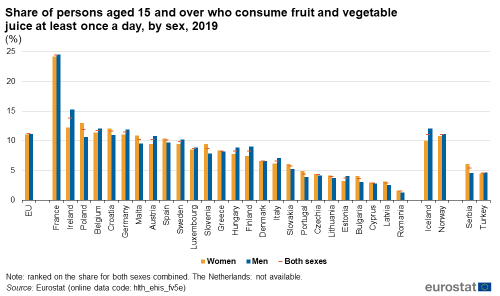
(%)
Source: Eurostat (hlth_ehis_fv5e)
In 14 EU Member States, higher shares of daily juice consumption in 2019 were recorded for women than for men; in Denmark, the shares were the same and in the remaining 11 Member States for which data are available a higher share of men than women consumed juice on a daily basis. The gender difference in daily juice consumption was narrower than 2.0 percentage points in nearly all Member States. The two exceptions were Poland, where the share among women was notably higher than that among men, and Ireland, where daily juice consumption was more common among men.
People with a high educational attainment were most likely to drink juice daily
The share of the EU population aged 15 years and over who, in 2019, reported drinking juice at least once a day was 13.0 % among those with a high level of education (see Figure 12). The share of daily juice consumption was lower among the population with medium or low levels of educational attainment.

(%)
Source: Eurostat (hlth_ehis_fv5e)
The same pattern was observed in 2019 among a majority of the EU Member States, 17 of the 26 for which data are available. In Estonia and Italy, the share of daily juice consumption was equally as high among the population with a medium level of educational attainment as it was among those with a high level. In Ireland, France, Austria and Slovakia, daily juice consumption was most common among people with a medium level of educational attainment, while in Germany, Finland and Sweden it was most common among people with a low level of educational attainment. In fact, Sweden was the only Member State where people with a high level of educational attainment were less likely to consume juice daily than people with medium or low levels of educational attainment.
Comparing the shares of daily juice consumption in 2019 between the three educational attainment levels, gaps of more than 4.0 percentage points were observed in three EU Member States:
- in Bulgaria (4.8 percentage points) and Greece (4.3 percentage points), the shares were highest among people with a high level of educational attainment and lowest among those with a low level;
- in Sweden (4.3 percentage points), the reverse situation was observed.
Sugar-sweetened soft drinks consumption
Around one fifth of the population in Belgium consumed soft drinks at least once a day
In the EU in 2019, one third (33.9 %) of the population aged 15 years and over reported consuming sugar-sweetened soft drinks (hereafter referred to simply as soft drinks) at least once a week; in other words, two thirds (66.1 %) drank soft drinks occasionally (less than once a week) or never. As such, soft drinks were consumed at least once a week by a slightly smaller share of people in the EU than was observed for fruit and vegetable juice.
- Just over 1 in 10 (9.1 %) of the reference population drank soft drinks at least once a day.
- Some 6.1 % of the population drank soft drinks 4 to 6 times a week, in other words somewhat less than once a day, but more than every second day.
- Close to one fifth (18.7 %) of the population drank soft drinks 1 to 3 times a week, in other words at least once a week but less than every second day.
In eight of the EU Member States, the share of the population aged 15 years and over who drank soft drinks at least once a day exceeded one tenth – see Figure 13. Note that no data are available for the Netherlands for soft drinks consumption. By far the highest share was observed in Belgium at 20.4 %, well above the next highest share, 12.4 % in Malta. Shares below 4.0 % were observed in Greece, Romania, Finland and the Baltic Member States – Latvia, Lithuania and Estonia. Note that this share is analysed by sex and educational attainment in Figures 14 and 15.

(%)
Source: Eurostat (hlth_ehis_fv7e)
A higher share of men than women consumed soft drinks at least once a day in each of the EU Member States
Figure 14 presents an analysis of daily soft drink consumption by sex; there is a clear difference between the two sexes. The share of men aged 15 years and over in the EU drinking soft drinks at least once a day was 11.7 % in 2019. For women, the share was 6.7 %, in other words 5.0 percentage points lower.
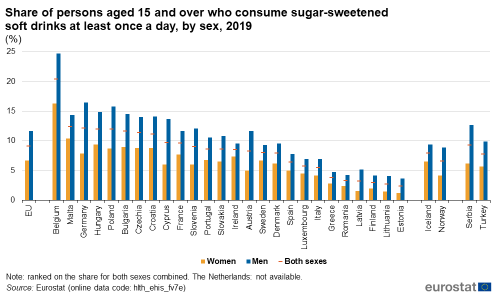
(%)
Source: Eurostat (hlth_ehis_fv7e)
Higher shares of daily soft drink consumption in 2019 were recorded for men than for women in all of the EU Member States. The gender difference in daily soft drink consumption was largest in Germany (8.6 percentage points) and Belgium (8.4 percentage points). Gender differences concerning the daily consumption of soft drinks were narrowest in several Member States with relatively low shares of daily consumers (below 5.0 %) and in Ireland.
Unlike for fruit and vegetable juice, a lower share of people with a high educational attainment drank soft drinks at least once a day compared with people with low or medium educational attainment
In the EU, 5.7 % of the population aged 15 years and over with a high educational attainment reported drinking soft drinks daily in 2019 – see Figure 15. The share of daily soft drink consumption was higher among the population with medium or low levels of educational attainment.
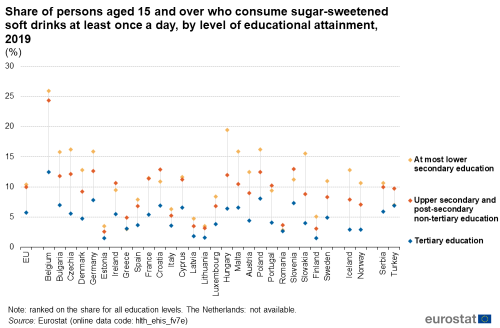
(%)
Source: Eurostat (hlth_ehis_fv7e)
The same pattern – people with a high educational attainment least likely to drink soft drinks daily – was observed in 2019 among nearly all of the EU Member States. Greece was the only exception: people with a low level of educational attainment were marginally less likely to consume soft drinks daily than people with a high level of educational attainment.
Equally, in a large majority of EU Member States people with a low level of educational attainment were most likely in 2019 to drink soft drinks at least once a day. However, in Ireland, Greece, Croatia, Portugal, Romania and Slovenia, people with a medium level of educational attainment were most likely to consume soft drinks daily.
In 2019, the largest range in the shares of daily consumption of soft drinks when analysed by educational attainment level were observed in Belgium, Hungary, Slovakia and Czechia: the shares were at least 10.0 percentage points higher among people with a low level of educational attainment than among people with a high level of educational attainment. In Belgium, a similar pattern was observed for people with a medium level of educational attainment, as their share consuming soft drinks on a daily basis was 11.8 percentage points higher than among people with a high level of educational attainment.
Source data for tables and graphs
Data sources
The third wave of the European health interview survey (EHIS) is the source of information for the data presented in this article. The general coverage of the EHIS is the population aged 15 years and over living in private households residing in the national territory. This source is documented in more detail in this background article which provides information on the scope of the data, its legal basis, the methodology employed, as well as related concepts and definitions.
The third wave of the EHIS was conducted in all 27 EU Member States, as well as in Iceland, Norway, Serbia and Turkey. The data collection period was generally 2019. However, it was 2018 for Belgium, 2018–2019 for Austria, and 2019–2020 for Germany and Malta. Note that data for the Netherlands are not available for the consumption of fruit and vegetable juices nor for the consumption of sugar-sweetened soft drinks.
Limitations of the data
The indicators presented in this article are derived from self-reported data. Therefore, they are to a certain extent affected by respondents’ subjective perception as well as by their social and cultural background.
Since fruit and vegetables ripen during a certain season each year, seasonal variations during which the survey was undertaken across countries may have affected reported consumption behaviour.
Coverage
Fruit includes fresh, frozen, dried and canned products, including fruit salad. Excluded are:
- fruit juice,
- fruit-based products such as pies,
- other ready (pre-prepared) meals which contain non-fruit/vegetable ingredients,
- nuts and peanuts.
Vegetables include fresh, frozen, dried and canned products and may be served raw or cooked. Pulses and beans are also included, but only for one portion a day. Excluded are:
- vegetable juice,
- vegetable-based products such as pies and soups,
- other ready (pre-prepared) meals which contain non-fruit/vegetable ingredients,
- potatoes and similar starchy foods.
A portion is more or less a handful (for instance, one apple or banana, two plums, a good slice of pineapple, two broccoli spears, three heaped tablespoons of cooked carrots, two-inch piece of cucumber, one medium tomato).
Fruit and vegetable juice may be home-made or purchased in shops, restaurants, bars, cafés and similar; the ingredients may be fresh or frozen. Included are pure fruit and vegetable juices separately or combined; pure fruit and/or vegetable smoothies are also included. Excluded are:
- soups (such as vegetable soups),
- juices from concentrates or processed fruits,
- juices with additives (such as sugar, salt, minerals or vitamins),
- smoothies with additives (such as water (including ice), dairy products, tea or chocolate).
Sugar-sweetened soft drinks include heavily-sugared beverages, such as lemonade, cola, ice tea, energy drinks, syrup-based drinks. These do not need to be carbonated, but often are. Excluded are:
- light, diet or artificially sweetened soft drinks,
- alcoholic beverages,
- coffee and tea, even if sweetened.
Context
A well-balanced diet including daily consumption of fruit and vegetables is an important determinant of health contributing to the prevention of chronic diseases, such as heart disease, cancer, diabetes and obesity. Unhealthy diets and physical inactivity may lead to a considerable health and budgetary burden.
In 2007, the White Paper on a Strategy for Europe on nutrition, overweight, and obesity-related health issues (COM(2007) 279 final) was adopted in order to promote an integrated EU approach focusing on healthy diets and physical activity. The White Paper establishes actions for the promotion of the consumption of fruit and vegetables especially in schools and in the workplace.
The European Commission funds several initiatives addressing nutrition and physical activity through the EU4Health programme 2021–2027.
Indicators on the consumption of fruit and vegetables are included in the determinants of health chapter of the European core health indicators (ECHI).
Direct access to
Online publications
Health status
Methodology
General health statistics articles
- Health (hlth), see:
- Health determinants (health_det)
- Consumption of fruits and vegetables (hlth_cfv)
- European health interview survey (EHIS) (ESMS metadata file – hlth_det_esms)
- European Health Interview Survey (EHIS wave 3) – Methodological manual – 2020 edition
- European Commission – Directorate-General for Health and Food Safety – European core health indicators (ECHI), see ECHI 49 and 50.
- European Commission – Directorate-General for Health and Food Safety, see:
- World Health Organization – Non-communicable diseases
- World Health Organization – Healthy diet
